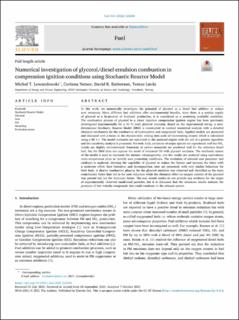| dc.description.abstract | In this work, we numerically investigate the potential of glycerol as a diesel fuel additive to reduce soot emissions. Many different fuel additives offer environmental benefits, since there is a surplus supply of glycerol as a by-product of biodiesel production, it is considered as a promising available candidate. The combustion process of glycerol in a direct injection compression ignition engine has been previously investigated experimentally for a 10 % (vol) glycerol emulsion. Based on the experimental set-up, a zero-dimensional Stochastic Reactor Model (SRM) is constructed to conduct numerical analysis with a detailed chemical mechanism for the combustion of hydrocarbon and oxygenated fuels. Applied models are presented and discussed with a focus on the characteristic mixing time scale of micromixing closure which is calculated using a 0D -. The model constants are optimized to the analysed engine with the aid of a genetic algorithm and the sensitivity analysis is presented. For both fuels, emissions of major species are reproduced well but NO results are slightly overestimated. Emissions of carbon monoxide are predicted well for the reference diesel fuel, but the SRM does not capture the trend of increased CO with glycerol emulsion. The stochastic nature of the model is used to represent the mixture inhomogeneity, and the results are analysed using equivalence ratio–temperature plots to identify soot promoting conditions. The evolution of selected soot precursor and oxidizers is analysed, showing the capability of glycerol to reduce the former and increase the latter with a moderate effect. Soot formation and decomposition rates are presented, with very similar behaviour for both fuels. A shorter combustion phasing for the glycerol emulsion was observed and identified as the main contributory factor that led to the soot reduction while the chemical effect i.e oxygen content of the glycerol was present but not the dominant factor. The soot model results do not provide any evidence for the origin of experimentally observed small-sized particles, but it is discussed that the emissions results indicate the presence of low volatile compounds that could condense in the exhaust system. | en_US |

